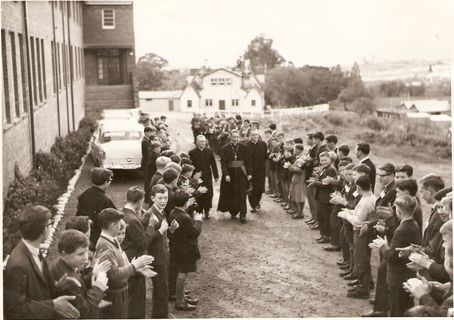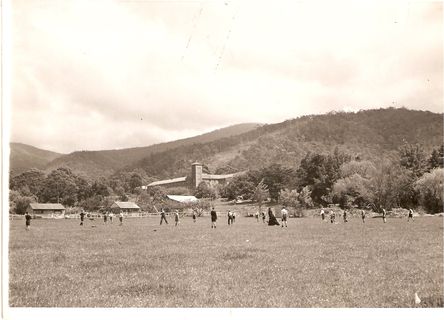Our Story
The origins and history of ÁñÁ«ÊÓƵ»ÆƬ
In 1946 the Salesians of Don Bosco were invited by Tasmania's then Archbishop Tweedy to come to Glenorchy to take over "Boys Town" an orphanage established by the Archdiocese, on a property purchased in May 1945. From November 1946, under the care of the Salesians, thirty boys lived and studied in the building known as Grantleigh (where the Business Office is located today) and its attached huts and amenities block. Fr John Brennan SDB, the school's first Principal wanted to build a modern school and expand the accommodation at Boys' Town.
The expansion of Boys Town
The post WW II Commonwealth migration schemes afforded the Salesian leadership the opportunity to expand the school. Their application for 40 British Child Migrants was eventually approved, and the funds the child migrants attracted, together with significant community fundraising, enabled the extension of the orphanage into a school. The official opening of the new Boys' Town Building was on Sunday 4 November 1951. Eight months later, in June 1952, the first group of what became 39 child migrants (who were considered abandoned) arrived from Britain.
The emergence of Savio College
In 1956 "day" boys were admitted to the school and prompted the name change to Savio College in that year. From then numbers gradually grew. From 1956 to 1961, the number of Savio students sitting for state-wide second year Catholic Secondary examinations (the equivalent of today's Year 8 or 9), increased from zero to 41.
Savio College provided for boys from Year 4 (Savio Primary at Bowden Street) to Year 12 (Secondary classes at Tolosa St as well as boarding provision continuing for boys).
The Dominican Sisters establish St John's and Holy Name
In 1959, at the invitation of Fr John Wallis, the parish priest of the newly established Parish of St John's Glenorchy, the Dominican Sisters arrived to establish a parish primary school. In 1962 the Dominican Sisters began the first secondary classes for girls in what was known as "The Barn" on Bowden Street, Glenorchy. From this start, Holy Name School came into being. Girls attended St John's Primary School and then Holy Name School for Secondary schooling.
The establishment of ÁñÁ«ÊÓƵ»ÆƬ
As early as 1967 some classes from Holy Name and Savio College had combined to sustain curriculum offerings. Co-educational French classes were conducted at Holy Name and Ancient History at Savio. In 1969 there was full integration of the matriculating students into one class, requiring careful coordination.
The Salesians and Dominicans recognised that more students would be staying at school beyond Year 10, and needed studies in senior years of a variety of disciplines. In 1971 all combined HSC classes were at Savio College, then, following full amalgamation, all senior classes (Years 10-12) were held at the Bowden Street campus.
In 1973, after two years of negotiating and planning, all the Catholic schools in Glenorchy – St John's Primary, Savio Primary, Holy Name School and Savio College – were amalgamated into one co-educational entity to be known as ÁñÁ«ÊÓƵ»ÆƬ. Dominic was the first Co-educational Catholic College in southern Tasmania. As the new entity was launched, 147 parents and friends attending the new P&F; heard there were 861 children enrolled (377 Primary, 303 Middle School, 181 Senior School).
ÁñÁ«ÊÓƵ»ÆƬ's Primary Campus was previously located on Bowden Street, where St John's Primary once existed. Holy Name and Savio Primary were transformed into the College's Senior Campus and the Savio College facilities on Tolosa Street became Dominic Middle School.
Guilford Young College began in 1995 with ÁñÁ«ÊÓƵ»ÆƬ Year 11 and 12 students moving into the amalgamated senior College for Catholic schools in Hobart. Dominic's Year 10 students were transferred to the Tolosa Street Campus, from this time on the Tolosa Street site was known as ÁñÁ«ÊÓƵ»ÆƬ Secondary Campus.
In 2004 ÁñÁ«ÊÓƵ»ÆƬ Primary Campus relocated to the Tolosa Street site and presently the entire college, from Kindergarten to Year 10, is housed on the one location set on 25 hectares of grass and bushlands.
The College owes its deep religious foundations to the Salesian and Dominican Orders. It is named after both St Dominic Savio, the schoolboy Saint and pupil of St John Bosco and St Dominic Guzman, the founder of the Dominican Order. The College's motto, 'Live by the Truth' is taken from the Third Letter of St John the Apostle. This concept is represented on the College shield, where the Torch symbolises the light of truth that will lead all to the Star – Christ.
ÁñÁ«ÊÓƵ»ÆƬ today
ÁñÁ«ÊÓƵ»ÆƬ continues to be owned and operated by the Salesians of Don Bosco. In Australia the Salesians own and operate schools, youth works, welfare agencies, and parishes, in several states. Their central office is located in Melbourne, Victoria. The College continues to be enriched by a community of Salesian priests and brothers who live at the school.
ÁñÁ«ÊÓƵ»ÆƬ continues to focus on the education of the whole child within a learning community and a faith community where each student is known, valued and nurtured to become more than they are now. The learning and teaching relationship is based on a belief in the potential of every student to achieve success. We value opportunities to gather as a community to celebrate student achievement and success.
Learning is considered a deep transformational activity of the heart. Pastoral Care is at the centre of daily life at Dominic. Staff and student relationships are based on the founder, St John Bosco's philosophy that 'the young must not only be loved, they must know that they are loved'.
Students are given a rich range of faith and spiritual development experiences. The Chapel is central to prayer and liturgical life. Outreach opportunities to develop a sense of service to others are important in the College's witness to the poor and needy. Students are encouraged to develop their leadership capacity, lead their peers and be role models for younger students. Establishing and sustaining strong friendships based on respect, kindness and loyalty across ages is very important at ÁñÁ«ÊÓƵ»ÆƬ.
 A Catholic School in the Salesian Tradition
A Catholic School in the Salesian Tradition


